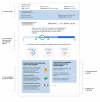Identification of Requirements for a Postoperative Pediatric Pain Risk Communication Tool: Focus Group Study With Clinicians and Family Members
- PMID: 35838823
- PMCID: PMC9338417
- DOI: 10.2196/37353
Identification of Requirements for a Postoperative Pediatric Pain Risk Communication Tool: Focus Group Study With Clinicians and Family Members
Abstract
Background: Pediatric surgery is associated with a risk of postoperative pain that can impact the family's quality of life. Although some risk factors for postoperative pain are known, these are often not consistently communicated to families. In addition, although tools for risk communication exist in other domains, none are tailored to pediatric surgery.
Objective: As part of a larger project to develop pain risk prediction tools, we aimed to design an easy-to-use tool to effectively communicate a child's risk of postoperative pain to both clinicians and family members.
Methods: With research ethics board approval, we conducted virtual focus groups (~1 hour each) comprising clinicians and family members (people with lived surgical experience and parents of children who had recently undergone surgery/medical procedures) at a tertiary pediatric hospital to understand and evaluate potential design approaches and strategies for effectively communicating and visualizing postoperative pain risk. Data were analyzed thematically to generate design requirements and to inform iterative prototype development.
Results: In total, 19 participants (clinicians: n=10, 53%; family members: n=9, 47%) attended 6 focus group sessions. Participants indicated that risk was typically communicated verbally by clinicians to patients and their families, with severity indicated using a descriptive or a numerical representation or both, which would only occasionally be contextualized. Participants indicated that risk communication tools were seldom used but that families would benefit from risk information, time to reflect on the information, and follow-up with questions. In addition, 9 key design requirements and feature considerations for effective risk communication were identified: (1) present risk information clearly and with contextualization, (2) quantify the risk and contextualize it, (3) include checklists for preoperative family preparation, (4) provide risk information digitally to facilitate recall and sharing, (5) query the family's understanding to ensure comprehension of risk, (6) present the risk score using multimodal formats, (7) use color coding that is nonthreatening and avoids limitations with color blindness, (8) present the most significant factors contributing to the risk prediction, and (9) provide risk mitigation strategies to potentially decrease the patient's level of risk.
Conclusions: Key design requirements for a pediatric postoperative pain risk visualization tool were established and guided the development of an initial prototype. Implementing a risk communication tool into clinical practice has the potential to bridge existing gaps in the accessibility, utilization, and comprehension of personalized risk information between health care professionals and family members. Future iterative codesign and clinical evaluation of this risk communication tool are needed to confirm its utility in practice.
Keywords: anesthesia; anesthesiology; anesthetic; child; decision aid; development; digital health; eHealth; focus group; individualized risk; pain; patient feedback; pediatric; pediatrics; postoperative; prediction; prototype; prototyping; requirement definition; risk; risk communication; surgery; user feedback; user-centered design.
©Michael D Wood, Kim Correa, Peijia Ding, Rama Sreepada, Kent C Loftsgard, Isabel Jordan, Nicholas C West, Simon D Whyte, Elodie Portales-Casamar, Matthias Görges. Originally published in JMIR Pediatrics and Parenting (https://pediatrics.jmir.org), 15.07.2022.
Conflict of interest statement
Conflicts of Interest: None declared.
Figures

Similar articles
-
An Individualized Postoperative Pain Risk Communication Tool for Use in Pediatric Surgery: Co-Design and Usability Evaluation.JMIR Pediatr Parent. 2023 Nov 17;6:e46785. doi: 10.2196/46785. JMIR Pediatr Parent. 2023. PMID: 37976087 Free PMC article.
-
Identifying Risk Factors, Patient-Reported Experience and Outcome Measures, and Data Capture Tools for an Individualized Pain Prediction Tool in Pediatrics: Focus Group Study.JMIR Perioper Med. 2022 Nov 15;5(1):e42341. doi: 10.2196/42341. JMIR Perioper Med. 2022. PMID: 36378509 Free PMC article.
-
Pediatric Delirium Educational Tool Development With Intensive Care Unit Clinicians and Caregivers in Canada: Focus Group Study.JMIR Pediatr Parent. 2023 Dec 11;6:e53120. doi: 10.2196/53120. JMIR Pediatr Parent. 2023. PMID: 38091377 Free PMC article.
-
User Requirements for Comanaged Digital Health and Care: Review.J Med Internet Res. 2022 Jun 10;24(6):e35337. doi: 10.2196/35337. J Med Internet Res. 2022. PMID: 35687379 Free PMC article. Review.
-
Design and user experience testing of a polygenic score report: a qualitative study of prospective users.BMC Med Genomics. 2021 Oct 1;14(1):238. doi: 10.1186/s12920-021-01056-0. BMC Med Genomics. 2021. PMID: 34598685 Free PMC article. Review.
Cited by
-
An Individualized Postoperative Pain Risk Communication Tool for Use in Pediatric Surgery: Co-Design and Usability Evaluation.JMIR Pediatr Parent. 2023 Nov 17;6:e46785. doi: 10.2196/46785. JMIR Pediatr Parent. 2023. PMID: 37976087 Free PMC article.
-
Parental Perspectives on Pediatric Surgical Recovery: Narrative Analysis of Free-Text Comments From a Postoperative Survey.JMIR Perioper Med. 2024 Dec 20;7:e65198. doi: 10.2196/65198. JMIR Perioper Med. 2024. PMID: 39705676 Free PMC article.
-
Severity and associated factors of postoperative pain in paediatric surgical patients aged 2 months-7 years at selected Addis Ababa Public Hospitals: a multicenter prospective longitudinal study.Ann Med Surg (Lond). 2024 Jan 17;86(3):1275-1282. doi: 10.1097/MS9.0000000000001742. eCollection 2024 Mar. Ann Med Surg (Lond). 2024. PMID: 38463099 Free PMC article.
References
-
- Rabbitts JA, Fisher E, Rosenbloom BN, Palermo TM. Prevalence and Predictors of Chronic Postsurgical Pain in Children: A Systematic Review and Meta-Analysis. J Pain. 2017 Jun;18(6):605–614. doi: 10.1016/j.jpain.2017.03.007. http://europepmc.org/abstract/MED/28363861 S1526-5900(17)30522-9 - DOI - PMC - PubMed
-
- Williams G, Howard RF, Liossi C. Persistent postsurgical pain in children and young people: prediction, prevention, and management. Pain Rep. 2017 Sep;2(5):e616. doi: 10.1097/PR9.0000000000000616. http://europepmc.org/abstract/MED/29392231 PAINREPORTS-D-17-0042 - DOI - PMC - PubMed
-
- Robillard JM, Bourne SC, Tam MT, Page PM, Lamb EA, Gogal C, Skarsgard ED, Afshar K. Improving the paediatric surgery patient experience: an 8-year analysis of narrative quality data. BMJ Open Qual. 2020 May;9(2):e000924. doi: 10.1136/bmjoq-2020-000924. https://bmjopenquality.bmj.com/lookup/pmidlookup?view=long&pmid=32381597 bmjoq-2020-000924 - DOI - PMC - PubMed
-
- Feinstein AB, Sturgeon JA, Bhandari RP, Yoon IA, Ross AC, Huestis SE, Griffin AT, Simons LE. Risk and resilience in pediatric pain: the roles of parent and adolescent catastrophizing and acceptance. Clin J Pain. 2018 Dec;34(12):1096–1105. doi: 10.1097/AJP.0000000000000639. http://europepmc.org/abstract/MED/30028367 - DOI - PMC - PubMed
LinkOut - more resources
Full Text Sources
Research Materials

